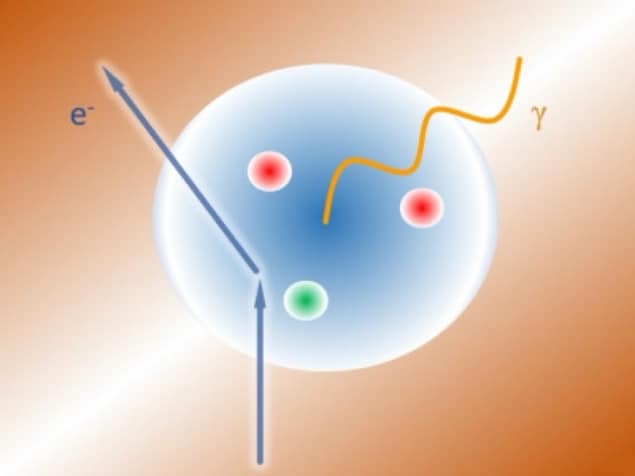Proton’s puzzling electromagnetic structure is observed in new experiment
28 Oct 2022
Collision course: diagram showing the real photon (γ) that is produced when an electron scatters from a proton. (Courtesy Nikos Sparveris/Temple University)
New electron scattering data from the US suggest that the electromagnetic structure of the proton may differ from theoretical predictions – an observation that partially corroborates earlier measurements done in 2000. The explanation for the anomaly is unclear, but the researchers believe more insights may emerge as increasing computing power allows theoreticians to perform direct calculations of the interactions between the proton’s constituent quarks.
The quarks inside a proton are bound by the strong interaction and the theory of quantum chromodynamics (QCD) describes how this interaction is mediated by gluons. The process is similar to how photons mediate the electromagnetic interaction in quantum electrodynamics, however unlike photons, gluons interact with each other as well as with the particles they bind. This makes calculations highly non-linear and often puts direct QCD predictions of collisions beyond available computing power. Researchers therefore rely on approximations, one of which is chiral effective field theory.
In 2000, researchers at the Mainz Microtron in Germany used the Compton scattering of virtual photons produced by collisions between electrons and liquid hydrogen to measure the generalized electric and magnetic polarizabilities of the proton. These show how easily a body deforms in response to electromagnetic excitations.
Disagreement with theory
Theory suggests the electric polarizability should decrease as one focuses deeper into the proton as the structure becomes stiffer. However, if the proton was assumed to have its conventional structure, the experimental data appeared inconsistent with the scattering pattern predicted by chiral effective field theory. “These measurements came with a large uncertainty, and in view of the lack of independent confirmation [the observation] was viewed with some reservation”, says Nikos Sparveris of the Thomas Jefferson National Accelerator Facility in Virginia and Temple University in Philadelphia.
In the new research, Sparveris and colleagues repeated the Compton scattering experiment, but used some advanced capabilities of the Jefferson lab to reduce the uncertainties. “We throw electrons at a proton, a virtual photon is exchanged between the electron and the proton, and then a real photon is produced at the end,” explains Sparveris. “The real photon produced exposes the system to the electric and magnetic field that you need to allow the polarizability to be measured; the energy of the virtual photon defines the scale of the observation.” The researchers measured the reaction at different energies and momenta exchanged in collisions – which defined the wavelength of the virtual photon.
If the proton becomes stiffer on smaller scales, the measured electric polarizability should drop smoothly with the wavelength of the virtual photon. Like the Mainz data from 2000, however, the Jefferson Lab data also seem to deviate from this trend.
Smaller, but there nonetheless
“At some point there is some local enhancement – a plateau or small bump where it temporarily increases before falling off again,” says Sparveris.“What we see [from the new results] is that there is indeed something there, not at the magnitude that was originally suggested – it appears to be smaller…but now we have two independent groups reporting it the question from the theory side is: if indeed something is really there, what can explain it?”
More theoretical insights may come soon increasing as computational power makes it possible to perform full lattice QCD simulations of the collisions at Jefferson Lab. “They will most likely be able to do it in the next few years,” says Sparveris. The experimentalists intend to perform more measurements to confirm that the peak does indeed exist and map out its shape. “Further into the future one would ideally like to measure this through an independent reaction channel, and this could potentially become available at Jefferson Lab if a positron beam were to become available.”READ MORE

“Such intriguing data!” says experimental nuclear physicist Ronald Gilman of Rutgers University in New Jersey. “The structure of the proton is complicated, and over many decades we keep finding that the simple assumptions we make before we can measure some property are just wrong…So it would be great if here again we have something new to learn!” He adds, however, that: “If the old uncertainties were underestimated a factor of two — which is not crazy — the significance of the peak would be much reduced, and you can just about imagine a smooth curve describing all the data pretty well… I would really like to see another new result of similar quality to this one before I become absolutely convinced.”
University of Maryland theoretical physicist Xiangdong Ji is more sceptical: “Every model predicts a monotonic decrease,” he says; “I would go so far as to say that the monotonic decrease is a generic feature of the theory that must be true.” He would therefore require an extremely high level of statistical significance to accept a contradictory conclusion: “[The researchers] have three data points, one of which looks slightly higher than the other ones – I think it’s not a statistically meaningful measurement,” he concludes.
The research is described in Nature.
Tim Wogan is a science writer based in the US
from physicsworld.com 30/10/2022

Δεν υπάρχουν σχόλια:
Δημοσίευση σχολίου